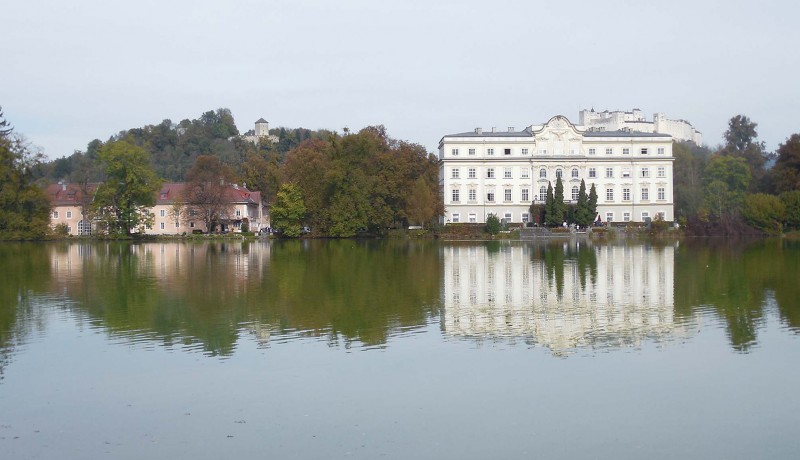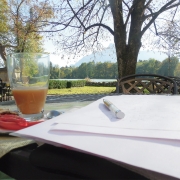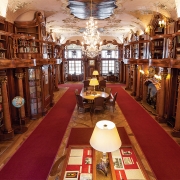
Etcetera

Manjiri Prabhu finds her muse in an ancient palace in Salzburg, the setting of her new novel The Trail of Four.
1998: My husband Bipin and I were backpacking in Europe for the first time. We were already bowled over by the serene emerald landscapes and amazing architecture of Europe. But when we reached Salzburg, Austria, somehow something was different. And that ‘something’ became more obvious when we took ‘The Sound of Music Tour’. That was when I first laid my eyes on the Schloss Leopoldskron. The bus passed the closed gates and the guide explained that The Sound of Music was filmed in this famous palace. Having loved the film and seen it several times, the beautiful palace represented all that was romantic, fun and perfect. As we glided past the gleaming lake, the palace on the opposite bank seemed like a magical glimmer, and only increased my craving for a closer look.
2002: Four years later, I was invited by the Salzburg Global Seminar to be part of a session titled ‘Page to Screen’ at the Schloss Leopoldskron. Spending a week there was one of the most memorable experiences of my life. Meeting like-minded souls, engaging in discussions with them, the ambience, the hospitality—the experience triggered an instant yearning to feature this palace in one of my novels. I believe that desire was the first step in the journey towards the creation of my mystery thriller The Trail of Four.
2014: Over the years, I swept through my job, penning other novels. Twelve years later, that yearning to feature the Schloss was still alive. I knew it was finally time to put thoughts into action. I reached out to Thomas Biebl, director of marketing and communications at the Salzburg Global Seminar. I was invited again to the Schloss to be a writer-in-residence. I have always believed that when things are destined to happen, they happen. And when for the third time my association with the Schloss began, my belief was strengthened further. It was as if the Schloss wanted me back, to complete an incomplete task, to fulfil an unfulfilled desire!
The Schloss, a Rococo (an early to late French 18th century artistic style) palace, was built in 1736 by Archbishop Firmian. Two years later, he died. His body was buried at Salzburg Cathedral but his heart was buried in the private chapel of the Schloss as a gesture of his love for it. The Schloss passed across many hands over the next century; it was acquired and renovated by famous actor-director Max Reinhardt in the 1920s. Reinhardt used the Schloss for his plays, inviting theatre personalities from around the world. However, during World War II, the Austrian-Jewish director had to flee to America when the Nazis took over the Schloss. Reinhardt died in 1942, apparently pining for the Schloss.
In 1947, three Harvard youngsters initiated the Salzburg Global Seminar (SGS) to challenge present and future leaders to solve issues of global concern. The Schloss is now owned by the Salzburg Global Seminar, which continues to host eminent personalities from across the world to support the evolving needs of change-makers across generations.
My original plan was to base a love story in Salzburg. But in retrospect, I can see how things changed. Jan Heinecke, fellowship manager of SGS, gave me a personal tour of the Schloss while narrating its history. I remember standing in the Marble Hall, staring up at the massive, long ceiling filled with frescoes, from the time of Archbishop Firmian, which exhibited and described in graphic and artistic detail four examples each in nature, science and geography. Frescoes of animals, people, weather references, scientific instruments, countries on the walls and ceiling and in the paintings—it was as if the number ‘four’ was the keyword in the world. And it was while I stood there, craning my neck parallel to the wide ceiling, that I knew my novel had to be a mystery thriller, where the Schloss was almost like a character. The presence of the ‘fours’ everywhere and their significance was the real trigger. They had to be a part of the novel. They had to be the novel.
When Thomas introduced me to the historic city of Salzburg, the idea became more solid, and a bigger plan began surfacing, hazy at first, and then so concrete that I saw a whole new novel grow inside of me. Thomas drove me to landmark monuments in the city, fed me authentic Austrian food, and basically made me live a complete Austrian experience. We discussed the book, the plotline, characters, history and more. But that is not the only reason why the novel was born. Incidents unfolded, discoveries were made and people connected…things aligned so I could write this novel.
The Trail of Four is a work of suspense that unravels over 48 hours. Re Parkar is an investigative journalist and filmmaker from Paris, who is prone to getting psychic visions of his next case. When he ‘visualises’ the Schloss Leopoldskron in black smoke, Re catches the first flight to Salzburg and explains his vision to Dan, the GM of the Schloss, who refuses to believe him. The Schloss is all set to be the venue of a seminar, where top leaders of states are expected to congregate. Just before the guests arrive, shockingly, the heart of the Archbishop is stolen from its holy grave in the Schloss Chapel and a letter from the dead and long-gone American-Austrian Max Reinhardt is found in its place, threatening the destruction of the four pillars of Salzburg.
Pressure mounts at this sudden and totally devastating turn of events. Stefan, the police officer in charge, is confident they will find the mischief-maker. Teams are sent out to all the ancient monuments of the old town to ensure no bombs are planted and to protect the historical pillars of Salzburg. But when, at the stroke of 12 pm, poisonous gas almost kills 12 people at the Mozart Birth House, the Polizei is stunned to realise that this is not the usual bomb scare technique of destruction.
The varied sculptures, frescoes on the ceilings of the Schloss, the hidden staircase in the library, beautiful gardens, the surrounding lake with ducks…each play an important role in the novel. But most important, the novel hinges on the trail set 75 years ago by Max Reinhardt and the four important pillars of Salzburg that were threatened to be destroyed.
With an able guide in Thomas, finding the pillars was relatively easy; we visited the ancient St Peter’s Graveyard, the crypt under the cathedral, the oldest cafes and churches and the Mozart Birth House. We even visited a private, exquisite bed and breakfast with its very own family chapel.
Setting the trail, though, was the real challenge: a trail that would be intriguing, difficult yet fun, and lead through clues to the secret hiding place of Reinhardt’s gift. A trail that would swing between the Schloss and the city of Salzburg in a smooth interplay of monuments and structures. Almost spurred on by an invisible spirit, I set about it in a very systematic manner. I explored every room in the Schloss, one by one, multiple times. I stepped into Max Reinhardt’s shoes, began thinking like he would, figuring out what I could use to set the trail. And as I began my little journey, I began unravelling my own fictitious trail. The first spot I considered was, of course, the Marble Hall with its display of frescos. The next was the most natural choice: the library. Modelled on the St Gallen monastery library in Switzerland, it was crying out to be featured in the novel. With its curved shelves and pillars, creaking boards and the warmth of wooden interiors, there couldn’t be a more cosy bookish landscape for the novel. It was here that I discovered a face and an owl carved on the ceiling. While I was exploring the secret staircase that ran from the library to Max Reinhardt’s suite, I also discovered the initials ‘R’ and ‘S’ embedded on the back of the staircase. Discoveries such as these led me to form the clues inside the Schloss.
Taking the trail outdoors was more difficult. However, I somehow felt guided by an extremely sharp instinct, instilled in me by some unknown force. I remember that I was very keen on featuring the path that ran along the lake, Leopoldskroner Weiher. I needed to find something distinctively unique that would catch the character’s eye. I took a slow long walk along the picturesque lake, observing ducks, watching the reflection of Untersberg Mountain in the lake, and then something caught my eye: a tree, old and gnarled to such an extent that it was totally bent over, almost hanging over the lake. I knew at once that I had found what I was looking for. The Schloss and its partner-building, the Meierhof, were visible through the branches.
While I researched on my own, took long walks and contemplated on what to include and exclude, wading through the flood of information, I also chatted with interesting people who helped me along the way. Especially memorable was the meeting with local historian Johannes Hofinger, who shared valuable nuggets of information.
One particular incident is carved in my memory. I had interviewed several people about the workings of the Schloss and the Meierhof (100 years older than the Schloss). The Meierhof had been recently renovated and I was keen to meet its architect Gerhard Baumgartner. One evening, I took my habitual walk to the old town. A map had been given to me with directions on how to return to the Schloss. I emerged out of a tunnel and glanced down the street. It was getting dark with not a single soul in sight. It didn’t take me long to realise that I was lost. For a second, I panicked. The shops were closed and the streets were empty. I was at the foot of the hill, looking at a narrow lonely path that seemed to wind up into the twilight that I hoped would end by the Schloss. However, I was hesitant. What if it were the wrong path? While I contemplated my next step, growing uneasy by the second, I spotted a man in a long jacket, approaching a parked car. Seizing the moment, I approached him, asking if he could speak English. He nodded. I asked him for directions to the Schloss. He offered to drop me. For a fraction of a second, I wondered if it was wise. It was dark and I was tired. Throwing caution to the wind, I climbed into the car, muttering a silent prayer. He asked me what I was doing at the Schloss. When I told him why I was there, he smiled and said that he was the architect of the newly renovated Meierhof. I simply stared at him! Queries rolled off my tongue. By the time we drew to a halt outside the Schloss, we had had a wonderful chat.
Perhaps this was a coincidence. But for me, it was a message from the universe. In fact, all along the signs had been clear and unambiguous. This novel was destined! And when I consider the entire manner in which this thriller was conceived and shaped, I find myself intrigued. From the urge of a regular tourist to a yearning, leading to a complete manuscript, the journey of this novel—of almost two decades—seemed to be premeditated. I was merely treading an assigned path, guided by a special spirit. Could it be that of the palace? Or someone else? Needless to say, I feel blessed to have been the chosen one.
The Trail of Four is my tribute to the Seminar, which does amazing work, and to the beautiful Schloss. But more important, to Salzburg, the city I fell in love with at first sight and dream to make my second home someday.
Photos: Manjiri Prabhu Featured in Harmony — Celebrate Age Magazine February 2017
you may also like to read
-
Cracking the longevity code
Small yet impactful choices can be game-changers, writes Srirekha Pillai At 102, there’s no stopping Chandigarh-based Man Kaur, the world’s….
-
Home, not alone
While a regulatory framework is vital for senior-care facilities, the need of the hour is to develop an ecosystem to….
-
Birthday Girl
Published in a special edition to honour Japanese master storyteller Haruki Murakami’s 70th birthday, Birthday Girl (Penguin; Rs 100; 42….
-
A huge treat for music lovers
Published as the revised and updated second edition, Incomparable Sachin Dev Burman (Blue Pencil; Rs. 599; 470 pages) the authoritative….









